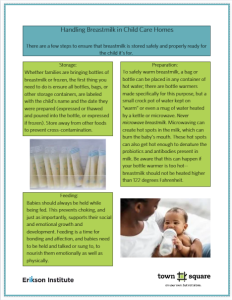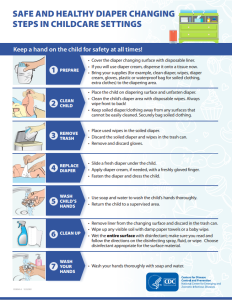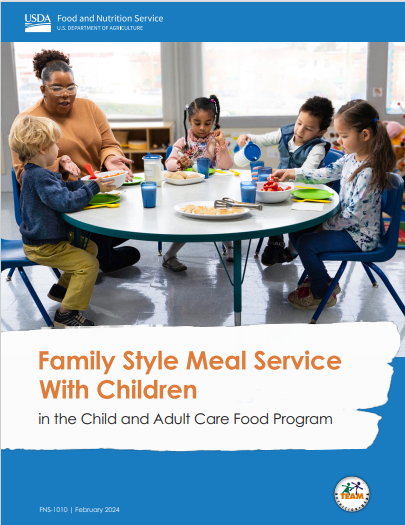If you are curious about family style dining, whether or not you’re currently on the food program, this short booklet will show you all the equipment you need, how to introduce the idea to children and their families, and tips for ensuring compliance with CACFP regulations.
Family Style Meal Service With Children in the Child and Adult Care Food Program (cacfp.org)
Una de las alegrías del cuidado infantil en familia es el tiempo que los proveedores pueden pasar con los niños a su cargo, y el crecimiento que se produce en esos años.
Esto también significa que los proveedores deben ser adaptables y estar dispuestos a cambiar su programa junto con los niños.
Comunicarse con las familias en el momento de la inscripción y comprobar periódicamente cuándo y cuánto tiempo duermen los niños, con qué frecuencia comen y cuál es su estado cuando llegan a casa (¿excesivamente cansados? ¿despiertos hasta las 11?) puede ayudar a informar sobre las rutinas a medida que los niños crecen.
Por supuesto, en grupos de edades mixtas, es muy probable que haya niños que tengan necesidades aparentemente contradictorias al mismo tiempo.
¿Cómo puede un proveedor ofrecer a un preescolar activo un tiempo adecuado al aire libre, al tiempo que alimenta a los bebés cuando tienen hambre, y atiende las necesidades de aseo y cambio de pañales a medida que surgen?
Hay tres cosas que hay que tener en cuenta para equilibrarlo todo (¡la mayoría de los días!):
- Preparación: La construcción de la rutina debe basarse en la comunicación con las familias sobre las necesidades de los niños pequeños, así como en las propias observaciones del proveedor.
No sólo debe tenerse en cuenta a cada niño como individuo, sino que el grupo en su conjunto sirve como otra perspectiva a considerar.
Cada vez que cambie la composición del grupo, es muy probable que también lo haga alguna parte de la rutina. - Equipamiento: Lo ideal es que haya espacios interiores y exteriores para jugar activa y tranquilamente, descansar y comer.
Por supuesto, el espacio puede ser escaso en cualquier guardería, así que la adaptabilidad es clave.
¿Puede una caja impermeable con pañales, toallitas, papel de mesa para pañales, jabón y toallitas de papel vivir cerca de la manguera del jardín? - Flexibilidad: no dejes que el reloj te estrese, es un punto de referencia, no tu jefe.
Si los niños están contentos jugando, ¡no dejes que el reloj te diga a ti o a ellos que es hora de parar!
Por el contrario, si algunos están claramente cansados y hambrientos, no dudes en mover el tiempo de comida y descanso en consecuencia.
Aunque muchos estados tienen normativas que obligan a alimentar a los niños y a darles siestas en un horario muy individualizado, no pasa nada por dejar que un niño cansado descanse o que un niño hambriento tome un vaso de leche u otro tentempié fuera de las horas de comida programadas.
Para reflexionar: ¿Qué momentos del día son los más difíciles para satisfacer las necesidades de todos?
¿Qué te ayudaría a colaborar con las familias en torno a la necesidad de rutina de los niños?
Manipular, almacenar, calentar y alimentar con leche materna puede parecer que tiene muchos pasos. Este PDF imprimible repasa cómo proporcionar leche materna de forma segura a los lactantes cuyas familias se la proporcionan, incluyendo el almacenamiento, la preparación y la alimentación. A continuación, también encontrarás un vídeo de Head Start en el que se ve a una profesora de Early Head Start dando el biberón a un bebé y demostrando la alimentación receptiva y la interacción con un bebé a la hora de comer. 
Gestión de la leche materna en el cuidado de los niñosHandlingBreastmilk
¿Qué notas en este vídeo de la profesora de Early Head Start dando de comer al bebé? ¿Cómo responde el bebé a sus acciones y a su forma de hablar?In the RIE philosophy, there is a great emphasis on ensuring that caregiving times are relaxed and enjoyable for children and their caregivers. While this might be a dramatic reframe for some– is it really possible to enjoy changing diapers? — it can make mundane tasks much more pleasant.
Family child care is a unique profession– some days drag out, but many others fly by. Taking any opportunity to slow down and be mindfully present with the children is a way to build relationships with each child and ensure that there is time each day spent in warm individual interactions.
The major criterion that makes an activity “want something” quality time is that the adult has an agenda for the child to participate in. This is typically participating in a care task like diapering/toileting, feeding/eating, or dressing. How can these sometimes stressful occasions become enjoyable for everyone? The answer is simple: play!
When a child is getting changed, songs and nursery rhymes (“This Little Piggy”, “Hickory, Dickory, Dock”) have natural gestures that can be incorporated into dressing the child. Taking some pressure off of meals and offering conversation or even calm games for older toddlers, like “I spy on my plate” or discussing the attributes of the meal.
It’s normal for a child to offer some resistance during care times; babies and toddlers try to roll away from diaper changes, or spit out food, or tantrum to avoid getting dressed. Approaching the child in the spirit of collaboration and fun, while not an immediate “cure” for these behaviors, will change the tone of these interactions over time.
Reflection Questions:
- What “want something” times are most difficult right now?
- Consider a child you have struggled to connect with, or who struggles when participating in care tasks: how and when could you use want something quality time to build that relationship?
In the Paths to Quality Standards for Participation, there are 13 standards that family child care providers must meet to move from level 1 to level 2. One practice states:
Each child feels safe, accepted, and protected. This is supported by daily practices that reinforce respect for people, feelings, ideas, and materials.
What does it mean to feel safe, accepted, and protected? What are daily practices that support children in feeling this way? Paying attention to each child and taking advantage of time to connect, even though this is difficult in group care, is a great start. Especially during caregiving times like feeding and diapering/toileting when children are at their most vulnerable. In the RIE philosophy of infant caregiving, this is called “want something quality time.” When the adult has a goal, but it can be accomplished mutually with the child’s cooperation, and the time can be spent in a pleasant interaction with the child rather than rushed through.
This is in addition to “want nothing quality time,” when adults spend time playing with, talking to, and observing children without another agenda. Helping children feel safe also involves self-reflection. Knowing how to handle children’s challenging behaviors is an ongoing process and requires some self-reflection to ensure that adult responses are compassionate and appropriate and demonstrate to the child that the adult isn’t a threat. It’s easy to forget that adults are many times the size of a young child and can easily feel frightening to them. As Circle of Security says, the adult must choose to be “bigger, stronger, wiser, and kind.”
Respect for ideas is simply listening to children and helping them have discussions together in a way that allows for free expression of thoughts without ridicule.
Respect for materials might be more complicated. One of the greatest frustrations in family child care can be broken materials! But daily practices that can support respect for materials might include helping children choose the right materials for their chosen activity (throwing sponge balls instead of blocks), and teaching and modeling appropriate use of materials such as paintbrushes and markers.
Reflection:
- How can you tell when a child is feeling safe?
- What frequent occurrence is most likely to dysregulate you? Spilled paint? Children squealing? How can you proactively support your own wellness and calm?
This printable PDF from the CDC
outlines the steps involved for a diaper change that minimizes the chance of spreading pathogens such as pinworms or hand foot and mouth. These are crucial to the health and safety of the provider and all of the children they care for.
What it doesn’t show is the incredible opportunity for relationship building that is also present at every diaper change. How often are you just a foot or so away from the child’s face for such a focused time? Spending diaper changes talking to the child is one high-impact way to build relationships, and also make the diaper changes themselves easier. What toddler is going to try to roll or wrestle away when one of their favorite people is talking to them, or playing “this little piggy” with their toes?
It doesn’t add a significant amount of time to really pay attention to the child being changed, but the payoff in peaceful diapering and overall relationship can’t be overstated!

